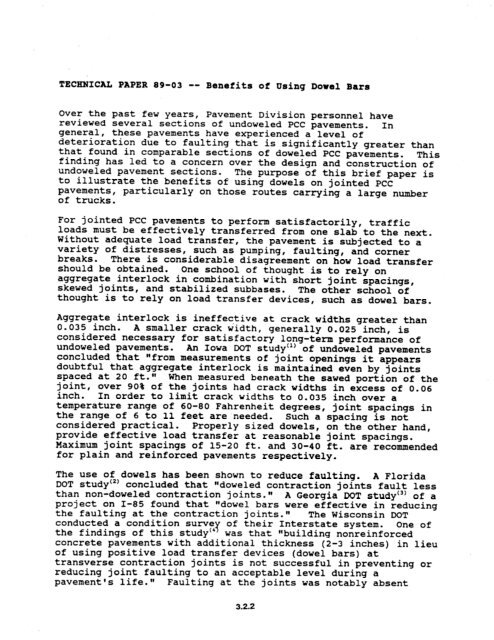chapter 3 rigid pavement - DOT On-Line Publications - Department ...
chapter 3 rigid pavement - DOT On-Line Publications - Department ...
chapter 3 rigid pavement - DOT On-Line Publications - Department ...
Create successful ePaper yourself
Turn your PDF publications into a flip-book with our unique Google optimized e-Paper software.
TECHNICAL PAPER 89-03 -- Benefits of Using Dowel Bars<br />
Over the past few years, Pavement Division personnel have<br />
reviewed several sections of undoweled PCC <strong>pavement</strong>s. In<br />
general, these <strong>pavement</strong>s have experienced a level of<br />
deterioration due to faulting that is significantly greater<br />
that found in comparable sections of doweled PCC <strong>pavement</strong>s.<br />
finding has led to a concern over the design and construction<br />
than<br />
This<br />
of<br />
undoweled <strong>pavement</strong> sections.<br />
to illustrate the benefits<br />
The purpose of this brief paper<br />
of using dowels on jointed PCC<br />
is<br />
<strong>pavement</strong>s,<br />
of trucks.<br />
particularly on those routes carrying a large number<br />
For jointed PCC <strong>pavement</strong>s to perform satisfactorily, traffic<br />
loads must be effectively transferred from one slab to the next.<br />
Without adequate load transfer, the <strong>pavement</strong> is subjected to a<br />
variety of distresses, such as pumping, faulting, and corner<br />
breaks. There is considerable disagreement on how load transfer<br />
should be obtained. <strong>On</strong>e school of thought is to rely on<br />
aggregate interlock in combination with short joint spacings,<br />
skewed joints, and stabilized subbases. The other school of<br />
thought is to rely on load transfer devices, such as dowel bars.<br />
Aggregate interlock is ineffective at crack widths greater than<br />
0.035 inch. A smaller crack width, generally 0.025 inch, is<br />
considered necessary for satisfactory long-term performance of<br />
undoweled <strong>pavement</strong>s. An Iowa <strong>DOT</strong> study"' of undoweled <strong>pavement</strong>s<br />
concluded that "from measurements of joint openings it appears<br />
doubtful that aggregate interlock is maintained even by joints<br />
spaced at 20 ft." When measured beneath the sawed portion of the<br />
joint, over 90% of the joints had crack widths in excess of 0.06<br />
inch. In order to limit crack widths to 0.035 inch over a<br />
temperature range of 60-80 Fahrenheit degrees, joint spacings in<br />
the range of 6 to 11 feet are'needed. Such a spacing is not<br />
considered practical. Properly sized dowels, on the other hand,<br />
provide effective load transfer at reasonable joint spacings.<br />
Maximum joint spacings of 15-20 ft. and 30-40 ft. are recommended<br />
for plain and reinforced <strong>pavement</strong>s respectively.<br />
The use of dowels has been shown to reduce faulting. A Florida<br />
<strong>DOT</strong> study'2' concluded that "doweled contraction joints fault less<br />
than non-doweled contraction joints." A Georgia <strong>DOT</strong> studyc3' of a<br />
project on I-85 found that "dowel bars were effective in reducing<br />
the faulting at the contraction joints." The Wisconsin <strong>DOT</strong><br />
conducted a condition surve of their Interstate system.<br />
the findings of this studyc4 T<br />
<strong>On</strong>e of<br />
was that "building nonreinforced<br />
concrete <strong>pavement</strong>s with additional thickness (2-3 inches) in lieu<br />
of using positive load transfer devices (dowel bars) at<br />
transverse contraction joints is not successful in preventing or<br />
reducing joint faulting to an acceptable level during a<br />
<strong>pavement</strong>'s life." Faulting at the joints was notably absent<br />
3.2.2
















